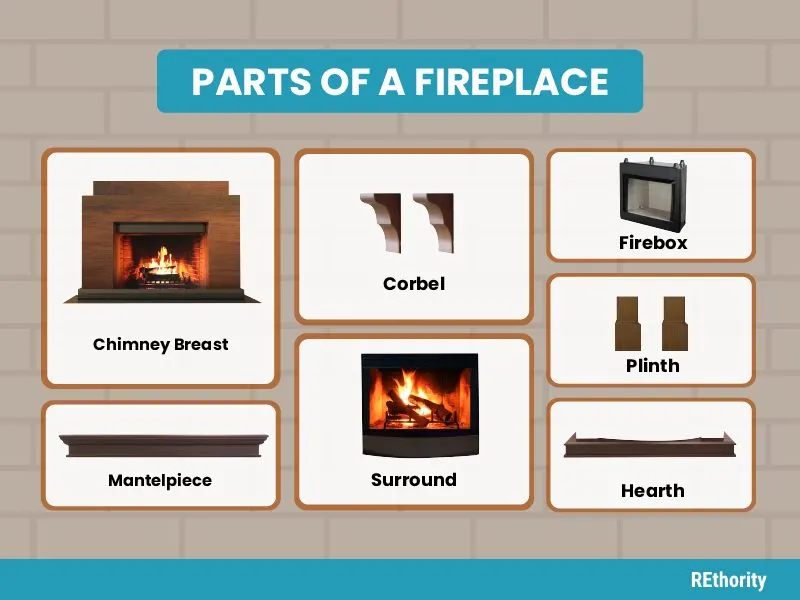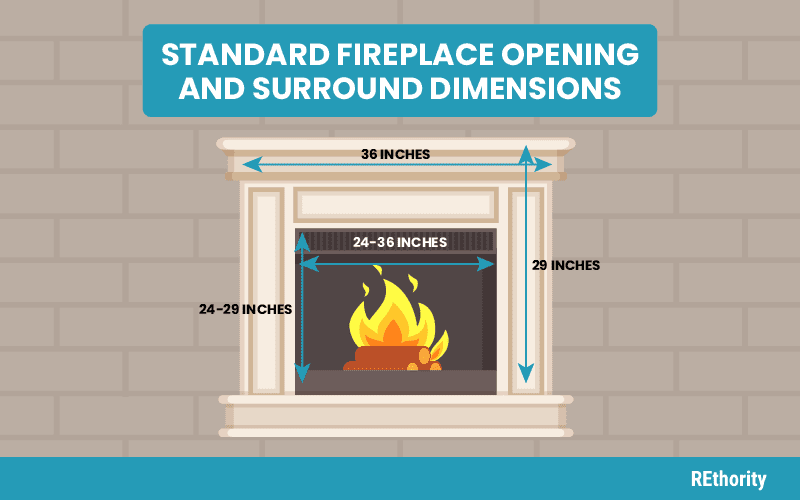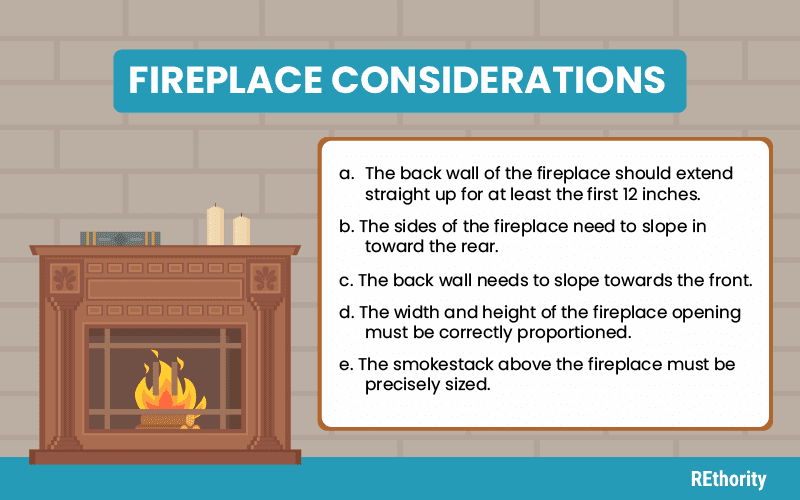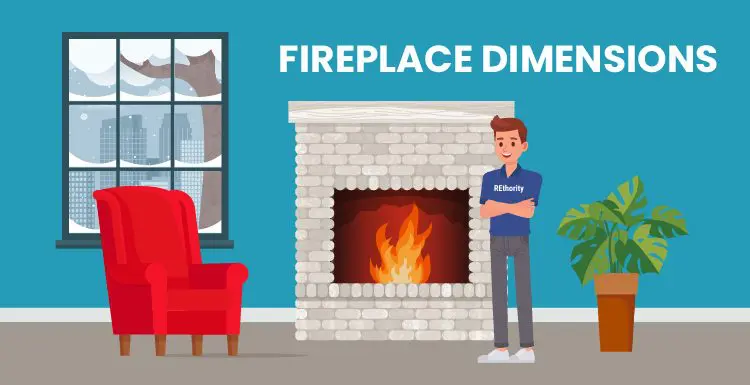Fireplace dimensions refer to the measurements of a fireplace, typically expressed in terms of height, width, and depth.
These dimensions are crucial for selecting appropriately sized accessories, ensuring proper ventilation, and determining the overall design and placement of the fireplace within a space.
Adding a fireplace to your home can really up a room’s ambiance, but it’s no small project.
It’s important to be aware of the typical fireplace dimensions and to plan thoroughly to ensure the project goes smoothly.
Short Summary
Obviously, not all fireplaces are the same. It’s important to note that the EPA recommends choosing the appropriate wood-burning appliance for your space and heating needs rather than selecting based on aesthetics alone.
However, there is an average range for the dimensions of a fireplace, regardless of the type or style you choose. While dimensions are not standard, there are a few rules of thumb. These include:
The Average Dimensions for Each Part of a Fireplace
The average fireplace has the following dimensions:
- An opening that’s between 24-36 inches wide, 24-29 inches high, and 16 inches deep.
- On average, the distance between the hearth and the damper is about 37 inches.
- The fireplace’s rear firebox is generally between 11 and 19 inches wide, with a height of 14 inches.
Standard Fireplace Dimensions

While there may not be a set of exact numbers for the typical dimensions of a fireplace, we can narrow it down to a range of averages for each of the main parts of a fireplace.
Main Parts of a Fireplace
Before we get into the specific dimensions of each fireplace component, it’s important to break down the anatomy of a standard fireplace.
Here are the main components of a fireplace and what they do:
Chimney Breast
The chimney breast is an extension of the chimney and extends into the interior of the home. These are usually made from brick or concrete and project from the wall.
Chimney breasts are integral parts of a home’s construction and support the fireplace. They also suck up the smoke, which is released through the exterior of the chimney on the roof.
Mantelpiece
The mantelpiece dates back to medieval times and has changed quite a bit over the years. Older mantelpieces were much more extravagant and often one of the defining features of the interior design of the room.
They also served a practical purpose: acting as a hood that prevented smoke from entering the room.
Modern fireplaces are generally simpler. They usually frame the fireplace’s opening and cover a portion of the chimney breast.
Most modern fireplaces also have decorative mantel shelves which can be used to display various objects and decorations.
Corbel
Corbels are used in many different forms of architecture. They can be defined as a structural piece of wood, metal, or stone that protrudes from a wall and is used to support the weight.
The corbel of a fireplace is located beneath the mantle and carries weight. Along with this functional purpose, there are also plenty of design options available when choosing corbels for a fireplace.
Surround
A fireplace surround refers to all of the components of a fireplace outside of the firebox.
Firebox
Though not as visible as the exterior parts of a fireplace, the firebox is the most critical component of all. This is where the fuel is combusted.
It typically sits on a piece of masonry attached to the floor and usually extends into the wall behind the fireplace.
Plinth
The plinth is a square box base that helps support columns. Plinths are also decorative pieces that create a seamless visual transition between the columns and the floor they connect to.
Hearth
The hearth is a slab of non-combustible material that sits on the floor in front of the fireplace. Common materials used for hearths include:
- Brick
- Stone
- Marble
- Cement
The hearth is a safeguard that protects your flooring from heat, embers, ash, and other combustible materials. It also serves the decorative function of tying your fireplace together.
Determining the Right Fireplace Size

There are several variables that will determine the ideal dimensions for a fireplace, including:
- The size of the room
- Personal style choices (such as the size of the mantlepiece)
- Materials: brick fireplaces generally take up more space than glass or metal ones
- Location of the fireplace within the room (corners vs. the center)
As we said before, it’s good to get an idea of the average dimensions of a fireplace. But determining your specific dimensions is a unique project.
If you’re not too experienced with major home improvement projects, we recommend seeking guidance from a fireplace design and installation professional. Professional guidance can help make sure your fireplace is well-constructed, safe, and visually appealing.
Frequently Asked Questions
Still got questions about fireplace dimensions? We’ve got answers to some of the most commonly asked questions by people looking into this subject.
Can a fireplace be too big?
Yes - as we mentioned before, the size of the room should be a major consideration when choosing the size of a fireplace.
A fireplace that takes up too much space can be overbearing. It might look odd from an interior design perspective and could bring too much heat into the room.
Should a fireplace mantel be wider than the fireplace?
Yes, the mantelpiece should always be wider than the fireplace. However, you don't want it to be too wide.
It should never reach any other major objects in the room, such as a window, door, wall, or shelf. Additionally, make sure to leave at least 3 feet above the mantle for decoration.
What are the most popular fireplace materials?
You have plenty of materials to choose from when planning a new fireplace.
Some of the most popular fireplace materials include:
1. Brick
2. Stone
3. Concrete
4. Metal
5. Plaster
6. Wood
7. Tile
Can a fireplace increase the value of a home? By how much?
Yes, a fireplace can add value to your home. According to a 2016 Angie's List survey of American real estate agents, over 68% of those surveyed believed a fireplace adds value to a home. Additionally, the survey found that over 83% of those surveyed estimated that a fireplace would add between $1,000 and $5,000 of value to a home. Even if you don't plan to sell your home anytime soon, it's good to know that adding a fireplace can be an investment. Plus, a retrofit for aesthetic reasons can also reduce air pollution.
How far should the mantle be above the fireplace?
According to the National Fire Protection Agency (NFPA), the mantel must be at least 12 inches above the top of the fireplace box.
Make sure to also check your local housing codes to see if their rules require more than a 12-inch cushion.
How far should a mantle stick out?
You want your fireplace mantle to stick out at least six inches, which will make sure it can deflect heat while still looking stylish.
Can you mount a TV above a fireplace?
Generally, it's not a good idea to mount a TV above a fireplace. The area surrounding the fireplace is likely the hottest part of the room, which means the heat could easily damage TVs and other electronics.
However, there may be an exception for electric fireplaces. Most of these release heat from the front or the bottom of the fireplace, so a wall-mounted TV above an electric fireplace is usually safe.
What are the most common fireplace sizes?
The average fireplace is approximately 36 inches by 30 inches, but there is plenty of variation in the fireplaces available on the market.
The most common fireplace sizes are:
1. 24 inches by 24 inches
2. 36 inches by 30 inches
3. 48 inches by 32 inches
How high should a fireplace be off the floor?
This can depend on how you're using the fireplace, but for most people, the fire will usually be viewed while seated.
If this is the case, you probably want your fireplace to be at about eye level when seated - roughly 40-42 inches off the floor.
How long can you leave a fireplace on?
This depends on what type of fireplace you have. Fully-vented fireplaces with sealed glass fronts can operate as long as you want them to.
If your fireplace does not have vents and has doors that open, you shouldn't leave it on for more than three hours.
How many inches of tile should I add to my fireplace?
Accenting a fireplace with tile is a common design choice. Usually, about 12 inches of tile is added to the fireplace surround section.
Things to Consider

There are a few universal rules to consider when planning a new fireplace. Follow these rules to avoid any potential complications:
- The back wall of the fireplace should extend straight up for at least the first 12 inches.
- The sides of the fireplace need to slope in toward the rear.
- The back wall needs to slope towards the front.
- The width and height of the fireplace opening must be correctly proportioned.
- The smoke stack above the fireplace must be precisely sized.
Final Thoughts
So there you have it—fireplace dimensions. Developing a plan for your home’s new fireplace takes a lot of time and effort, but it’s worth it in the end.
The newfound comfort and interior design upgrade will make you glad you undertook such a challenging project.
Just remember: you don’t have to do it all on your own. If you think you need guidance, don’t hesitate to reach out to a fireplace professional for help.

